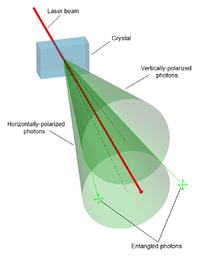
Photo from wikipedia
We built and evaluated a prototype quantum radar, which we call a quantum two-mode squeezing (QTMS) radar, in the laboratory. It operates solely at microwave frequencies; there is no downconversion… Click to show full abstract
We built and evaluated a prototype quantum radar, which we call a quantum two-mode squeezing (QTMS) radar, in the laboratory. It operates solely at microwave frequencies; there is no downconversion from optical frequencies. Because the signal generation process relies on quantum mechanical principles, the system is considered to contain a quantum-enhanced radar transmitter. This transmitter generates a pair of entangled microwave signals and transmits one of them through free space, where the signal is measured using a simple and rudimentary receiver. At the heart of the transmitter is a device called a Josephson parametric amplifier, which generates a pair of entangled signals called two-mode squeezed vacuums at 6.1445 and 7.5376 GHz. These are then sent through a chain of amplifiers. The 7.5376 GHz beam passes through 0.5 m of free space; the 6.1445 GHz signal is measured directly after amplification. The two measurement results are correlated in order to distinguish signal from noise. We compare our QTMS radar to a classical radar setup using conventional components, which we call a two-mode noise (TMN) radar, and find that there is significant gain when both systems broadcast signals at $-$82 dBm. This is shown via a comparison of receiver operating characteristic curves. In particular, we find that the quantum radar requires eight times fewer integrated samples compared to the TMN radar to achieve the same performance.
Journal Title: IEEE Transactions on Aerospace and Electronic Systems
Year Published: 2020
Link to full text (if available)
Share on Social Media: Sign Up to like & get
recommendations!